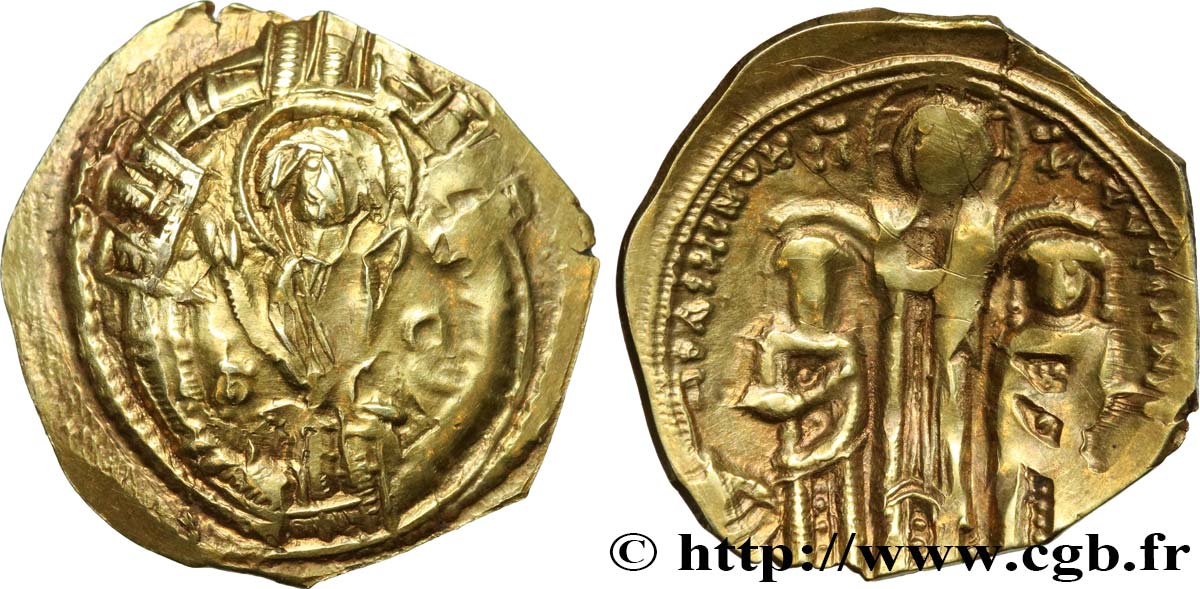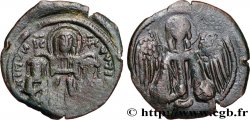bby_535296 - ANDRONICUS II PALEOLOGUS und MIKÄEL IX ANDRONICUS II Hyperpère
Nicht verfügbar.
Artikel auf unserem Online-Shop verkauft (2020)
Preis : 350.00 €
Artikel auf unserem Online-Shop verkauft (2020)
Preis : 350.00 €
Type : Hyperpère
Datum: 1295-1320
Name der Münzstätte / Stadt : Konstantinopel
Metall : Gold
Durchmesser : 22 mm
Stempelstellung : 6 h.
Gewicht : 2,93 g.
Seltenheitsgrad : R2
Kommentare zum Erhaltungszustand:
Exemplaire sur un petit flan quadrangulaire, irrégulier, bien centré des deux côtés. Frappé avec un coin usé, mais particulièrement bien lisible sur les légendes au revers. Belle patine rougeâtre
N° im Nachschlagewerk :
Pedigree :
Cet exemplaire provient de MONNAIES 45, n° 898
Vorderseite
Titulatur der Vorderseite ANÉPIGRAPHE.
Beschreibung Vorderseite La Vierge rayonnante de face ; autour, les murailles de Constantinople ; double grènetis.
Rückseite
Titulatur der Rückseite IC - XC.
Beschreibung Rückseite Andronicus II à gauche et Michel IX à droite couronnés par le Christ debout de face ; double grènetis.
Legende des Reverses : AUTOKATO
Übersetzung der Rückseite (Jésus Christ/ rois des Romains).
Kommentare
Poids excessivement léger. Or jaune. Flan bombé (scyphate). H. Berk signale que ce type doit être rendu à Andronicus II et Andronicus III Paléologue entre 1325, date à laquelle il fut associé au pouvoir par son grand-père et 1334, date de la disparition du monnayage. Le dit grand-père est décédé deux ans plus tôt, mais continue à être associé au monnayage.
Excessively light weight. Yellow gold. Domed flan (scyphate). H. Berk reports that this type must be attributed to Andronicus II and Andronicus III Palaeologus between 1325, when he was associated with power by his grandfather, and 1334, when the coinage disappeared. The said grandfather died two years earlier, but continues to be associated with the coinage
Excessively light weight. Yellow gold. Domed flan (scyphate). H. Berk reports that this type must be attributed to Andronicus II and Andronicus III Palaeologus between 1325, when he was associated with power by his grandfather, and 1334, when the coinage disappeared. The said grandfather died two years earlier, but continues to be associated with the coinage








 Berichten über einen Fehler
Berichten über einen Fehler Die Seite drucken
Die Seite drucken Teilen meiner Auswahl
Teilen meiner Auswahl Stellen Sie eine Frage
Stellen Sie eine Frage Einlieferung/Verkauf
Einlieferung/Verkauf
 Details
Details





